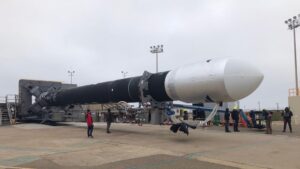In addition, Noosphere Ventures, Firefly’s largest investor, sold $100 million of its holdings to some of the Series A investors through secondary transactions to satisfy what the company called “overwhelming demand” in the funding round.
In January, Tom Markusic, chief executive of Firefly, said the company was looking to raise $350 million to fund the ramp-up of its operations over the next five years and development of a larger, medium-class launch vehicle. That remains the goal, he said in a recent interview, but the company decided to split the funding into two separate rounds.
“The rationale for doing that is that, in general, you don’t want to take more money than you need as a startup company, because it involves the dilution if you take too much,” he said. “But you do want to take enough so that you have enough runway to get the things you need to get done in the near term.”
A smaller round allows some investors to come in a “relatively low” valuation, he said. The larger round, which could come after the first Alpha launch, would be at a higher valuation, “minimizing dilution and also benefiting those investors that came in on an earlier round.” That larger round, which Firefly expects to be $300 million, could be raised later this year.
The Series A round, he said, is sufficient to fund the company for the next year even on an “aggressive” development schedule. “I’m just so confident that the accomplishments of the company are going to be so substantial in the next year that it makes sense for us to sort of go for it and not take a lot more than we need right now.”
The group of Series A investors are “people that have a passion for space,” he said. “It’s always great to have investors that aren’t just financial investors, that they actually are excited about the mission and they want to be involved in the mission.” One of those investors, Jed McCaleb of Astera Institute, an organization that describes itself as “researching and discovering high leverage technology” to benefit society, will join Firefly’s board.
The company’s first Alpha rocket is at Vandenberg Air Force Base in California as the company conducts final tests of both the vehicle and the launch site ahead of its inaugural launch. Markusic said the company was hoping to perform a static-fire test of the rocket in the coming weeks but the “awkward stops and starts” inherent with first-time launch operations made it impossible to offer a more precise date.
“So, we’re just taking a slow and measured approach to it, making sure we do everything carefully,” he said. “I’d be disappointed if we don’t launch in the next couple months.”
Three more Alpha launches are on the company’s manifest for October of 2021 and January and June of 2022. The June 2022 launch will be for the NASA Venture Class Launch Services contract the company won last year.
The first launch will also test technology for an orbital transfer vehicle called the Space Utility Vehicle, such as its solar electric thruster. In parallel, the company is working on Blue Ghost, its lunar lander. The company won a NASA Commercial Lunar Payload Services award in February for that lander’s first mission, delivering a set of payloads to the moon in 2023.
“The lunar lander is really the first contract that validated our end-to-end space transportation paradigm that we’re trying to put forward at Firefly,” Markusic said. “Blue Ghost, the lunar lander, has really energized the spacecraft side of the business.”
That’s helped grow the company to more than 350 employees. The company is preparing to open a new 50,000-square-foot facility at its Cedar Park, Texas, headquarters to support work on its lunar lander and orbital transfer vehicle projects.
Firefly continues to pursue a medium-class launch vehicle, called Beta. Markusic said that recent announcements by companies like Relativity Space and Rocket Lab that they would develop medium-class vehicles validated its own plans for a larger vehicle. “I’ve seen that some other companies are suggesting that they’re going to do similar vehicles to Beta, which is smart, because it’s clear to us that there’s a market there.”
The new funding round will support design work on Beta, leading toward a conceptual design review. Markusic said that will include how to best incorporate reusability into the vehicle, as well as development of larger engines to power the vehicle.
“The long pole will be the engines,” he said. “Propulsion will be the big focus in the next few months, which is great, because I love rocket engines.”



